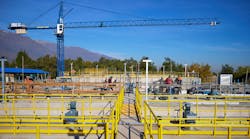Dozens of northeastern Illinois communities are stripping their drinking water of cancer-causing radium, only to dump the radioactive element back into the environment in sludge spread on farm fields and wastewater pumped into rivers and streams, the Chicago Tribune reported.
According to state officials, the disposal methods do not threaten human health, food crops or wildlife. However, critics, including some federal regulators, fear that in the rush to make drinking water safer, towns might be trading one radium problem for another.
The report said that communities including Joliet, Channahon and Geneva draw drinking water from deep wells laced with naturally occurring radium. In order to comply with federal regulations, most of the towns flush the element through their sewage plants, dividing it between treated wastewater and nutrient-rich sludge that farmers welcome as an inexpensive fertilizer.
Recent federal report indicated that future homeowners could inherit a significant problem if suburban sprawl transforms the farmland into subdivisions. As radium decays, it forms radon, an odorless gas that seeps into basements and can cause lung cancer.
Releasing concentrated radium into rivers and streams could harm fish and other aquatic life, critics said.
In an August draft report intended to give local officials advice about radium treatment and disposal methods, the U.S. Environmental Protection Agency concluded that spreading radium-contaminated sludge on corn and soybean fields could create radium hot spots that would require future cleanup, according to the Chicago Tribune.
The report said that sludge may be good for crops; however, "EPA believes such benefits should be weighed against potential hazards and risks of the practice."
U.S. EPA regulations has ordered utilities to reduce radium in drinking water to 5 picocuries per liter of water. The rules, along with a federal appeals court ruling, strengthened a legal standard that has been on the books since the mid-1970s.
Source: Chicago Tribune


